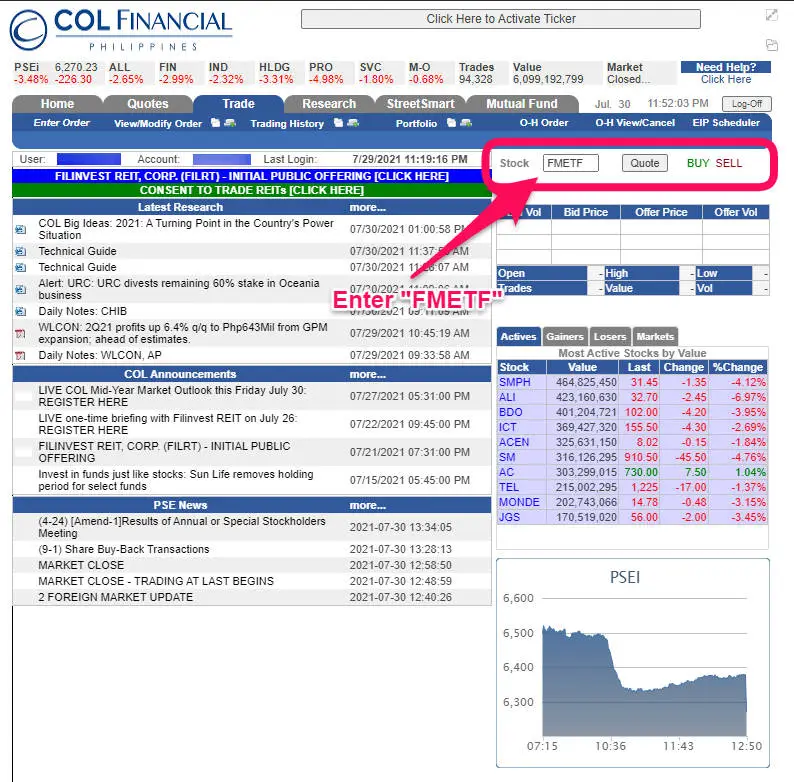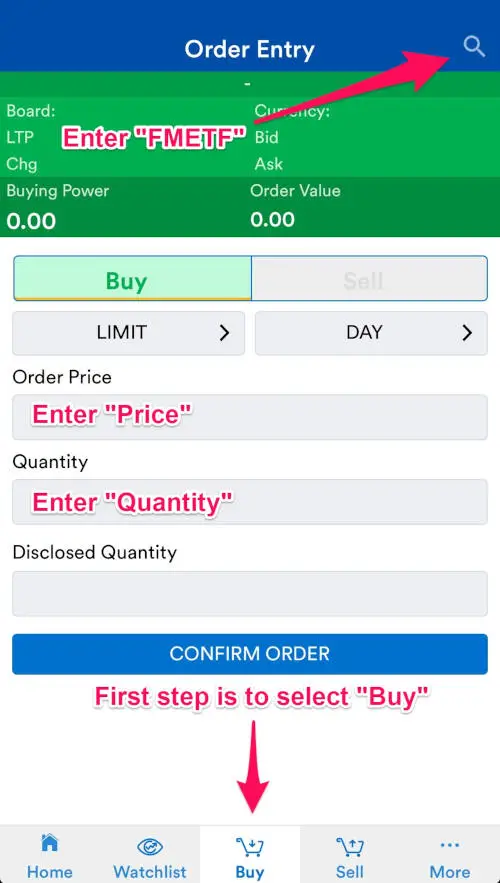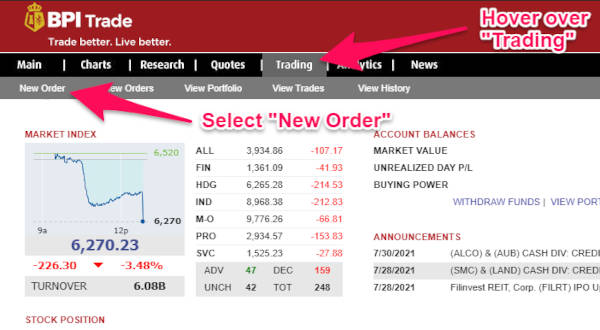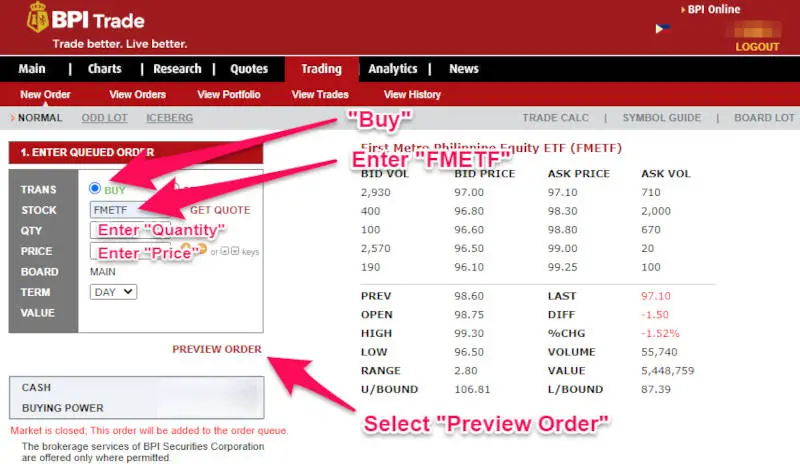Stock picking is NOT the best way to invest in the stock market for most people. If we play by the odds and follow peer-reviewed research, you’re likely going to do worse trying to select winners versus simply investing in an index that tracks the market. FMETF, or the First Metro Philippine Equity ETF (exchange-traded fund), is a cheap way of investing in an index that tracks the Philippine stock market.
And although I am a proponent of holding a global portfolio (See Asset Allocation for Filipinos: A Global Portfolio Overview), I also understand that a little home-country bias is warranted. FMETF is my preferred way of gaining exposure to the local stock market.
What do you need to know about FMETF? Is it safe; how much does it cost; how do you earn from it? Is it easy to buy? When should you buy? If I’m against stock selection and timing the market, then why do I use a modified approach vs. straight-up cost-averaging? What if you’re willing to take a riskier position for a chance at larger returns, does the FMETF still make sense?
All these and more!
(The big assumption here is you’re a long-term investor of around 5 to 10 years. Alternative strategies are probably better for shorter time horizons.)
Page Contents
What is the FMETF?
I’d be remiss if I didn’t mention FMETF’s official website: https://www.firstmetroetf.com.ph/
But in a nutshell, FMETF is an ETF that tracks the PSEi. The PSEi is an index, or a basket, of companies representing the PSE.
- ETF = exchange-traded fund (Traded on a stock exchange like any other stock.)
- PSEi = PSE Composite Index (We’ll occasionally call this “the index.”)
- PSE = Philippine Stock Exchange
In short, it’s an investment instrument that tracks the Country’s stock exchange.
Why is this relevant? Is the FMETF a good investment?
When we speak of investing in the stock market, most people think about carefully selecting stocks and buying at the right price and right time. Yet studies show that it’s very (and I mean incredibly) hard to beat the market by pure skill and talent — excess returns called your alpha. Even Warren Buffett’s returns have recently been explained by strategic exposures to certain factors rather than pure alpha. And he, too, is a proponent of investing in an index.
(Coming soon: Explaining Warren Buffett’s Returns by Factor Investing)
All things considered, you’re likely going to do better investing in an index than active stock selection.
How does FMETF Work?
FMETF mimics PSEi’s holdings at approximately the same percentages. As the fund manager, First Metro Asset Management, Inc. (“FAMI”) adjusts its holdings by buying and selling to match the index’s weights.
So if, say, Aboitiz Equity Ventures, Inc. comprises 3.19% of the index, then FMETF will try to hold approximately the same weight.
Both the PSEi and FMETF list of companies, and their actual weights per company, are found here (link to a page on FMETF’s website). If you’re interested in the portfolio mix per sector, it’s found here (link to FAMI’s website).
The ETF then trades, like a regular stock on the stock exchange, at the computed NAV per Unit (Net Asset Value per Unit) — our FMETF NAV. This is the price you see when you log on to your stock brokerage account.
FMETF vs. alternatives
Now, if the fundamental reason for investing in FMETF is exposure to the Philippine stock market, can’t we do the same via UITFs and Mutual Funds tracking the same index?
And we certainly can. UITFs, such as the BPI Invest Philippine Equity Index Fund, and Mutual Funds, like the PhilEquity PSE Index, have the same objective — to track the index.
(You may refer to https://www.uitf.com.ph/ for a list of UITF equity funds; First Metro’s ETF brochure compares ETFs, Mutual Funds, and UITFs.)
That said, FMETF’s main advantage over the current alternatives is cost-efficiency, particularly its low management fees.
FMETF fees explained
Fund managers charge a management fee that’s based on the total assets under management (“AUM”), and FMETF’s management fee is the lowest in the Country at 0.50%. These fees are deducted by the fund manager and adjustments are made to the NAV.
In contrast, comparable index funds by UITFs and Mutual Funds charge a management fee of at least 1%.
(As an equity investment, I am assuming your time horizon is long term and the additional transaction costs of ETFs are covered by the savings in annual management fees.)
This seemingly small difference is in fact significant. A 0.5% difference in returns of a lump sum 1 million pesos investment today is approximately 870,000 pesos more by year 30, assuming annual returns of 7%. (870,000 pesos is the difference between a 1 million investment that compounds at 6.5% vs. 6%.) The larger the assumed annual returns, the greater the impact of the 0.5% difference.
FMETF expense ratio commentary
While FMETF’s expense ratio is a Country-best 0.50%, this is still higher than the international average of ETFs. Vanguard, the global leader in low-cost ETFs, has an average expense ratio of 0.09%, with the industry average ETF expense ratio at 0.28%. (Data from Vanguard’s footnotes.)
Purely speculating here, but I imagine this has to do with FMETF’s AUM relative to its management fees. At the same fixed costs to manage any fund, the resulting management fee in percentage terms is higher when the AUM is lower. Then again, that doesn’t explain the higher management fees of comparable UITFs and Mutual Funds that have larger AUM. Are the latter two inherently more costly to manage? I do not know.
At the end of the day, FMETF still looks like the cheapest option for exposure to the PSE.
How do you make money with FMETF?
The premise of investing in the FMETF, and effectively in the stock market, is the economy’s growth. We assume economic output increases over time, and this increase is manifested by the increase in company valuations. Since FMETF is a fund that invests in companies that comprise the stock market, the fund’s value also increases.
So how do you make money with FMETF?
Investors earn by buying the FMETF and selling at a price that’s more than they bought it for — a typical case of buying low and selling high.
We’re essentially betting on long-term economic growth.
PSEi vs. FMETF
Since the profitability of investing in the FMETF depends on the stock market’s performance, and the stock market’s performance is proxied by the PSEi, it’s helpful to know whether or not the FMETF effectively tracks the PSEi.
We can measure this by having a look at the correlation coefficient and tracking error between FMETF and the PSEi.
FMETF and PSEi correlation coefficient
Using online data from December 2013 to July 2021, I’ve found that the correlation coefficient between the FMETF and PSEi was 0.90. This implies a strong connection between FMETF and PSEi.
(A correlation coefficient of 1 means they move in perfect unison.)
FMETF tracking error
In support of the correlation coefficient, the tracking error measures the standard deviation in returns between the FMETF and PSEi. (That is how accurately it tracks the index.) A lower tracking error is preferred.
Rather than relying on online claims about the tracking error, I went on and used the same data from Investing.com.
The resulting FMETF tracking error was 0.55%. Somewhat higher than claims of 1 basis point, but still pretty good anyway.
The takeaway? FMETF satisfactorily tracks the PSEi.
How to buy FMETF?
I hope by now you’re convinced how FMETF is the smart way of investing in the PSE stock market. An index is likely to outperform an actively managed fund net of fees, and the FMETF is a cost-efficient way of gaining exposure to the index.
Because the FMETF trades like a stock, you’ll need to open a brokerage account.
(FMETF’s stock name is “FMETF”)
And because management fees add up, the extra step to open a stock brokerage account, versus investing in a UITF managed by your bank, is well worth the effort for long-term investments.
Although the next part partially answers the query “FMETF where to buy,” what follows isn’t a recommendation of the best stock brokerage firms in the Philippines. Instead, they’re here because these are where I have my investments — frankly an arbitrary decision.
Feel free to open an account with any of the listed online brokers on PSE’s website: https://www.pse.com.ph/directory/#tp1 (If this link doesn’t work, try manually searching for the “Trading Participants” at PSE’s official website.)
These are also local stock brokerages for buying and selling stocks in the Philippine Stock Exchange. For investing in the international markets, check out my post on Interactive Brokers for Philippine residents.
How to buy FMETF in COL Financial
On COL Financial’s homepage, navigate to the stock search bar and enter the ticker “FMETF.” You may choose to see the current price by selecting “Quote,” or proceed with the buy order by selecting “Buy.” The buy button will direct you to a buy order page where you’ll finalize your order.
At the time of this writing, FMETF’s board lot is 10 shares. This board lot will apply as long as FMETF’s price floats around 50 pesos to 999.50 pesos.
(See COL Financial’s explanation on board lot and price fluctuations.)
How to buy FMETF in BDO Nomura
BDO Nomura’s website has a dedicated tab for trading. Select that and follow the steps as shown.
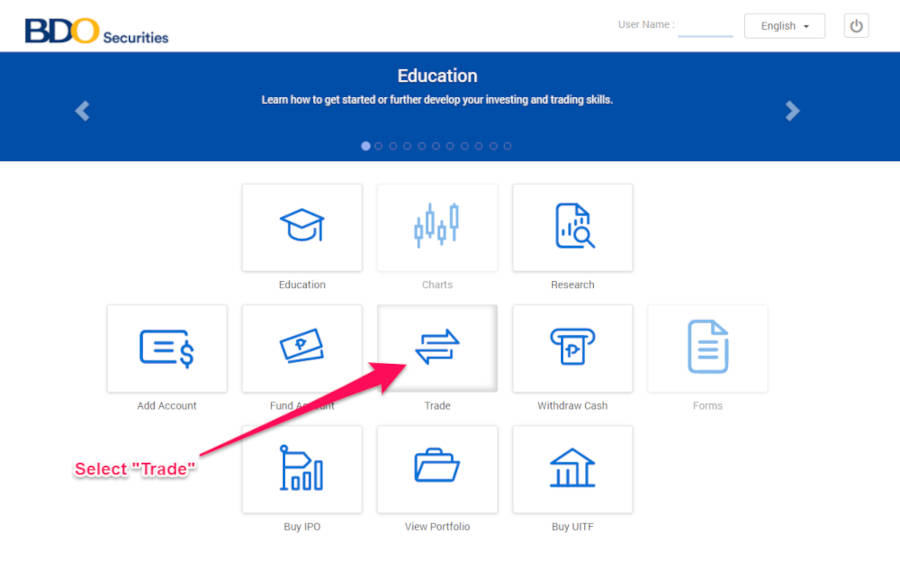
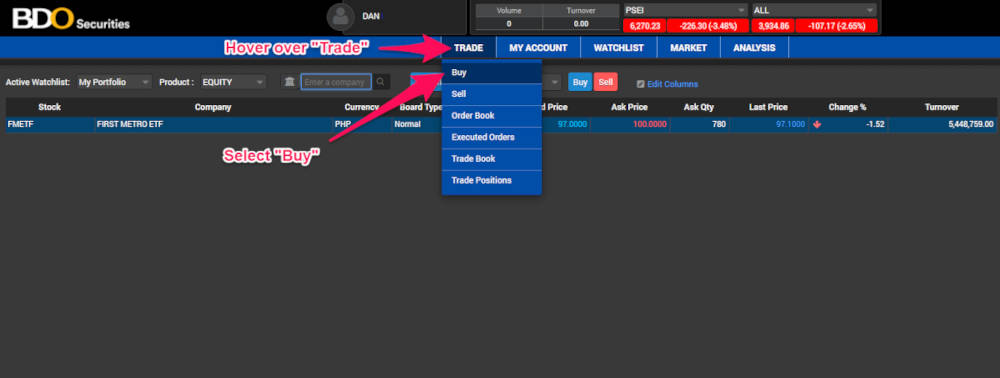
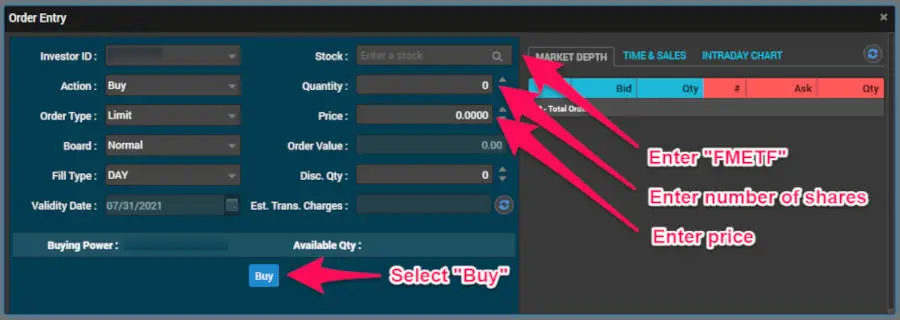
Alternatively, BDO Nomura’s app allows the same process with fewer steps.
How to buy FMETF in BPI Trade
On BPI Trade’s homepage, hover over the “Trading” tab and select “New Order.” You will be directed to the order page where you’ll enter the transaction details.
After you click “Preview Order,” you’ll be asked to confirm the trade by entering your BPI Trade password.
What’s the minimum amount to buy FMETF?
The current FMETF board lot is 10 shares, and it’s expected to stay at 10 shares as long as the price per FMETF share is from 50 pesos to 999.50 pesos. This means the minimum amount to buy FMETF is 10 shares multiplied by your price per share (i.e., quantity x price) plus your stock broker’s fees.
So at a price of 100 pesos per share, that’s a little over 1,000 pesos (i.e., 100 shares x 10/share) when we include fees. (See the applicable transaction fees & taxes at PSE’s website.)
But the 8k Rule suggests buying at least 8,000 pesos to optimize costs — because the commission charged by brokers is “0.25% of the amount invested or 20 pesos, whichever is higher.”
Do you need to follow the 8k Rule for FMETF?
It’s not necessary to follow the 8k Rule when investing long-term. In a previous study, my conclusion was, for expected returns of over 7% p.a., it makes sense to invest right away despite the lower amounts not meeting the 8,000 pesos criterion.
You can read more about the 8k Rule and the 7% Rule (a highly recommended read for its relevance to FMETF investing) here: The 8k Rule is Misused: New 7% Rule for PSE Stock Market Investing.
When to buy FMETF?
One strategy is to buy FMETF regularly through an iteration of Peso-Cost Averaging. But buying more when it’s cheap, based on an adjusted Buffett Indicator, can be an alternative.
The quick answer is to never time the market. Time in the market is better than timing the market. You increase your chances of earning more the longer you stay in the market.
An easy system to follow for most people is peso-cost averaging (“PCA”) — it’s when you consistently buy shares at regular intervals. Whether or not it works depends on your outlook. Read my Peso-Cost Averaging Advanced Guide: Know if It Works for You
But for full transparency, I do not follow a strict PCA strategy. My modified approach is based on an adjusted Buffett Indicator that tells me when the PSEi is cheap or expensive. It affords me the advantage of slowing down when the market is seemingly overbought, as well as the aggressiveness to buy more when the market is seemingly oversold. You can read more about it here: Buffett Indicator Philippines: Adjusted for the PSE
(I regularly send updates on the adjusted Buffett Indicator via newsletter so consider subscribing! Also, read about how this examination of the modified Buffett Indicator shows returns of 19% p.a. in the PSE stock market.)
What if I’m willing to take a riskier position than the market average?
Taking the FMETF approach is also possible for investors with higher-than-average risk tolerances. A basic tenet in finance is the high-risk high-return tradeoff. Some are willing to take on higher risks for the chance at higher returns. Since investing in the FMETF is, by definition, the market average, how can aggressive investors take advantage of the index?
(Related: The Risk and Return Trade-off Applied in Real Life (Uncommon Examples))
The answer lies in adding specific investments that overweight your exposure to certain factors. So, for instance, if you’re bullish on the property sector, then you could first invest in the index (FMETF) and then add a few more property stocks (e.g., ALI, MEG, FLI, RLC).
In effect, your portfolio now allocates a greater proportion to the property sector. If the PSEi and FMETF have 22% in the property sector, then adding property stocks means you’re overweighting the allocation in property stocks to more than 22%. If your bullishness is correct and property stocks do go up more than expected, then your portfolio benefits. But if you’re wrong and the property stocks’ performance is subpar, then your portfolio returns will be lower than average — there’s too much weight on the subpar sector.
Honestly, the casual investor shouldn’t even bother with stock selection, but it is an option.
(Related: Make Money Trading Stocks? The Advice You Didn’t Want to Hear)
Conclusion: FMETF is the way for a majority of investors
We as human beings have a tendency to overestimate our skills. And this includes our abilities to beat the market through technical and fundamental analyses.
Stock investing is actually more accessible than you may think. Open a stock brokerage account, buy the FMETF, and let time work its magic.
Rather than stock picking that’s ultimately based on assumptions that we’ll never be sure of, index fund investing is the recommended approach for a vast majority of people. Peer-reviewed researches have downplayed the role of alpha. And if index fund investing (e.g., FMETF investing) is good enough for the greatest investor of our time to recommend for the layman, then I’m not one to argue against it.



